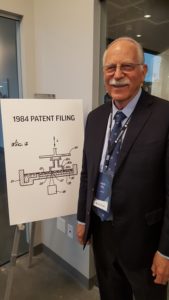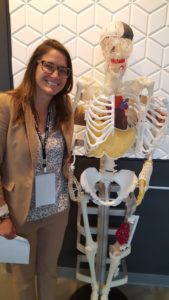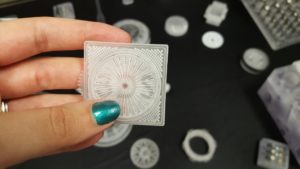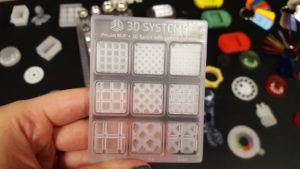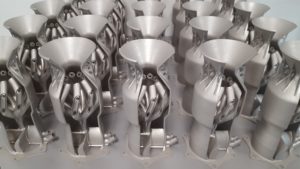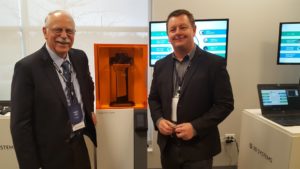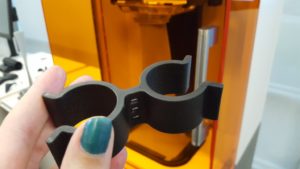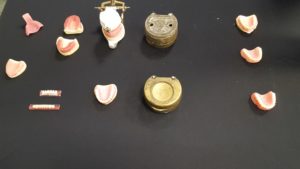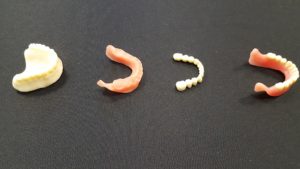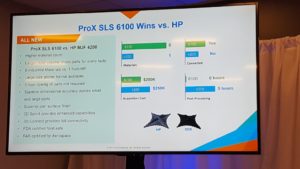“It is a different ball game,” 3D Systems President and CEO Vyomesh Joshi (VJ) told me.
 The company gathered financial and industry analysts together with media in a curated tour of its facility in Littleton, Colorado yesterday as a slew of portfolio announcements emerged showcasing an aggressive launch to market of new 3D printers, 3D printing materials, software, and business strategies and partnerships. While many companies are looking to change the shape of the 3D printing industry, including relative newcomers to the market like Carbon in 2015 and HP in 2016, the company with the deepest industry roots — and patents tracing back to the early 1980s — is not going quiet into the good night of mounting competition. On the heels of a notably disappointing quarterly performance, 3D Systems is arising with figurative guns blazing and is, to mix metaphors, running full-steam ahead.
The company gathered financial and industry analysts together with media in a curated tour of its facility in Littleton, Colorado yesterday as a slew of portfolio announcements emerged showcasing an aggressive launch to market of new 3D printers, 3D printing materials, software, and business strategies and partnerships. While many companies are looking to change the shape of the 3D printing industry, including relative newcomers to the market like Carbon in 2015 and HP in 2016, the company with the deepest industry roots — and patents tracing back to the early 1980s — is not going quiet into the good night of mounting competition. On the heels of a notably disappointing quarterly performance, 3D Systems is arising with figurative guns blazing and is, to mix metaphors, running full-steam ahead.
Throughout the launch event, 3D Systems executives were on hand to demonstrate, illustrate, educate, and discuss the latest introductions and strategies. VJ led the morning’s presentations detailing the announcements, alongside Phil Schultz, SVP and General Manager, On Demand Solutions and Plastics; Kevin McAlea, EVP and GM, Metals and Healthcare; and Herbert Koeck, SVP and GM, Go to Market. Additionally on-site, among many other executives and representatives, were Katie Weimer, VP, Medical Devices, whom I had previously met at the Littleton facility last year and who will be speaking tomorrow at #3DTalk NYC; Patrick Dunne, VP, Advanced Application Development, whom I last spoke with at TCT Show in September and at RAPID this spring; and Carol Zampell, VP, Software, who filled us in on software announcements a few months back. Widely known as the father of 3D printing, Chuck Hull was also present to share his thoughts on Figure 4 3D printing, which arose from his 1984 patent.
- L-R: VJ, McAlea, Koeck, Schultz
- Carol Zampell
- Chuck Hull with his 1984 patent that inspired the Figure 4. Image courtesy of 3D Systems.
- Katie Weimer
Amidst the lively presentations and hands-on facility touring, I sat down with VJ to talk with him directly about this latest launch. With so much to unpack from the veritable mountain of announcements, it was no surprise the straight-shooting CEO had a lot to say, even after speaking all morning.
“What I want to talk about is that 3D Systems is uniquely positioned to address the entire manufacturing workflow end to end,” VJ told me. “To do that, you need to really start with the customer and understand the use cases; help them in moving from prototyping to production.”
He pointed to one of the slides from his presentation, highlighting 3D Systems’ four keys to making 3D production real: productivity, durability, repeatability, total cost of ownership (TCO).
These, he underscored, underlie the basis to the company’s approach to providing viable solutions for its customers. Understanding exactly what a customer needs and then providing the right solution is at the heart of 3D Systems’ strategy. Following closely behind that understanding is the ever-important selection of materials; throughout the day, VJ and the other executives emphasized again and again the critical nature of the right material for the right job, as chemistry is key to the realities of additive manufacturing as a solution.
“First we understand the use case, and the materials. Once you know the use case and the materials, then you figure out with the application engineering what kind of solutions we are going to build. That solution, if you can build on our plastics portfolio or metal portfolio where you can scale up, using the same materials going from prototyping to what I call pilot run to production, then it’s a way we will be able to move companies into additive manufacturing,” he explained.
“What we are announcing is not another printer or another new material, it is an approach where we can engage with the customer and offer them a suite of solutions where we can make that happen.”
VJ has steered the company to adhere to this strategic approach since assuming the mantle of CEO in April 2016, frequently and fairly transparently sharing his vision for the future of 3D Systems. The whole of his tenure has been focused thus far on guiding the sometimes-troubled company toward a more successful future. By keeping focus on the customer and developing specific, customizable, scalable solutions, the team at 3D Systems are looking to set themselves on course for industry-leading offerings. The company’s broad portfolio encompasses professional plastic and metal 3D printing technologies, materials ranging from metal powders to biocompatible dental resins, and software, all buoyed by what should be an unshakable advantage in the form of three-plus decades of additive manufacturing experience and expertise.
“My vision is the following: if you are a customer, you come to us, saying, ‘This is the use case I want to figure out. It is complex or a custom part I want to do.’ We help them in selecting the right materials and right product, and the software workflow, and create experiments. The R&D team will experiment and create a part they are confident in, then work with their marketing team to understand what volume I can sell that at; then we can tell them the right product software and solution, going from standalone to factory solutions. Once we have that figured out, we figure out whether they want to do it in-house or use our On Demand Manufacturing capability. Then we can provide support all the way. That’s the story,” VJ told me.
- Chuck Hull and Scott Turner
Looking to the journey at hand, VJ pointed to the modularity of the Figure 4 system as an example. The scalable solutions available under the Figure 4 umbrella range in price from a $25,000 investment to a $1 million-plus setup, all scalable and adaptable to each individual customer. The ability to “pick and choose,” VJ said, is a benefit for the customer as well as for the company along for the journey with them. Should a customer choose to scale up their operations, they will have the option to add to their Figure 4 3D printing setup.
“They can scale up, the materials are the same, they are guaranteed to get the same end result that they started with as they scale up. We are the only company to do this in plastics and in metals as a full solutions,” he said.
As a “crude analogy,” VJ said, a customer can “think of a Chinese menu; you choose this, choose that, say this is what we will make happen.”
 He looked as well to the “important message” of the dental industry, which is “a tremendous opportunity” for 3D printing. During the facility tour, solutions from NextDent, which 3D Systems acquired in January, were showcased to illustrate the benefits of moving toward digital solutions from traditional dental lab configurations.
He looked as well to the “important message” of the dental industry, which is “a tremendous opportunity” for 3D printing. During the facility tour, solutions from NextDent, which 3D Systems acquired in January, were showcased to illustrate the benefits of moving toward digital solutions from traditional dental lab configurations.
“We look at dentures as an indication for Figure 4, looking at it as it is done now, a manual, messy process, versus a very clean process where you get a very accurate denture. This is just one example of how we are going to transform the dental industry. We are going to go use case by use case in creating more shapes more ways,” he said.
- All the steps in traditional denture manufacture
- Steps involved in digital dentistry
Altogether, the keys as VJ sees them are “worfklow focus, the potential to scale up, the right materials, the platform idea on the plastics side, and then the same approach on the metals side.” The event in Denver was set as a beacon for 3D Systems’ way of approaching the market, he explained.
“Essentially this was a very big introduction, not just of a product portfolio but a customer engagement model,” VJ told me. “We have a holistic way of helping the customers in all the segments so that they can move up – as a customer adopter.”
While many companies do not yet have the experience with additive manufacturing to allow for broader adoption, 3D Systems is looking to reduce barriers to market entry, working with and educating potential customers on how 3D printing can enhance their workflows. VJ acknowledged immediately that 3D printing will never be the end-all-be-all singular solution in manufacturing — “A customer may send us ten designs, and our application engineers will say that five of them will not work, you can have a traditional process do that; for the other five, let us help you” — and that customized solutions are achievable through building relationships that encourage technology adoption.
It also became clear throughout the day that part of 3D Systems’ aggressive approach to the market is in a no-holds-barred candid response to the competition. During the morning’s presentations, several slides directly compared 3D Systems’ offerings to those of competitors, laying out prices and cost of ownership versus HP’s Multi Jet Fusion technology and Carbon’s CLIP. Several surprised gasps (and a flurry of activity on Twitter) were evidence that attendees had not expected quite that level of candor when confronting the shape of the market.
- Oh snap.
“Everybody right now is talking about trillions of dollars and printers, rather than saying how they are really going to help the industry to go through this journey,” former HP executive VJ told me more obliquely.
As we have been hearing quite a lot recently about the intention to disrupt the $20 trillion global manufacturing industry via additive manufacturing, his comment carried a weight of context to it. I took the opportunity to ask him about the gloves-off response to the competition.
“I want to give you a much deeper view. In our portfolio, we have the 800 as the gold standard in SLA — the competition here is Union Tech, and we are better — we have the 2500 in jewelry — where the competition is SolidScape — we have the 320 in healthcare, we are the best, nobody can do that kind of thing. And as for the rest, we are working on it,” he said, unafraid to dig in.
“The new product, the 8500, will get us in the game in a very forceful way. In SLS, it is HP and EOS as the competition. HP is essentially now squeezed between our Modular 6100 and Production systems – if you are a customer and name a number of products to be made, we can say, go to this one, go to that one, it will be cheaper than that. If you want a bigger build volume, you can go 6100, if you want production, you go production. We want to give them choices about what to use, not just to say here is one solution. For Carbon, the price point is very high, it is $40,000 per year available on a leasing system; we have a solution that is $25,000 altogether – and it will be faster, and have more materials. It is modular and can scale up; Carbon has no scale up.”
As for the claims of who is and is not the best, I’ll leave that to those using all of these technologies as part of their regular operations. It’s clear, though, that VJ and his team have been doing their homework and are aware of which machines they see as the most direct competitors. Among those whose names came up throughout the conversation, and from the other executives’ presentations, as the key figures of competition are HP, Carbon, EOS, Formlabs, and Concept Laser. 3D Systems has its sights set on domination, and is targeting a large swath of the market.
3D Systems is also, of course, working alongside a number of key partners throughout its operations as it seeks to build strong relationships and offer versatile solutions. Software partnerships with such well-known platforms as SOLIDWORKS and business relationships such as the new contract announced with BMW showcase the company’s team-player spirit alongside the focus of leadership.
For VJ, the whole conversation boiled down to growth, as he explained:
“Our portfolio was only this small, but now that it is this big, and with the customer engagement model, it is a different ball game. Customers recognize and know how to deal with that.”
There’s still more to unpack from yesterday’s broad event, and I’ll be catching up with 3D Systems — as well as most of their named competitors — next week as formnext brings the 3D printing industry together in Frankfurt.
What do you think of 3D Systems’ latest strategies? Discuss this story and other 3D printing topics at 3DPrintBoard.com, or share your comments below.
[All photos: Sarah Goehrke]
Subscribe to Our Email Newsletter
Stay up-to-date on all the latest news from the 3D printing industry and receive information and offers from third party vendors.
You May Also Like
3D Printing News Briefs, April 13, 2024: Robotics, Orthotics, & Hypersonics
In 3D Printing News Briefs today, we’re focusing first on robotics, as Carnegie Mellon University’s new Robotics Innovation Center will house several community outreach programs, and Ugogo3D is now working...
Rail Giant Alstom Saves $15M with 3D Printing Automation Software 3D Spark
3D Spark has entered into a three-year deal with the rail giant Alstom. Alstom, a transport behemoth with annual revenues of $16 billion, specializes in the manufacture of trains, trams,...
Meltio Expands Global Reach with New Partnerships in the Americas and Europe
Spanish 3D printing manufacturer Meltio has expanded its sales network across the globe. With the addition of three new partners in the United States, Brazil, Argentina, and Italy, Meltio aims...
3D Printing Webinar and Event Roundup: April 7, 2024
Webinars and events in the 3D printing industry are picking back up this week! Sea-Air-Space is coming to Maryland, and SAE International is sponsoring a 3D Systems webinar about 3D...




